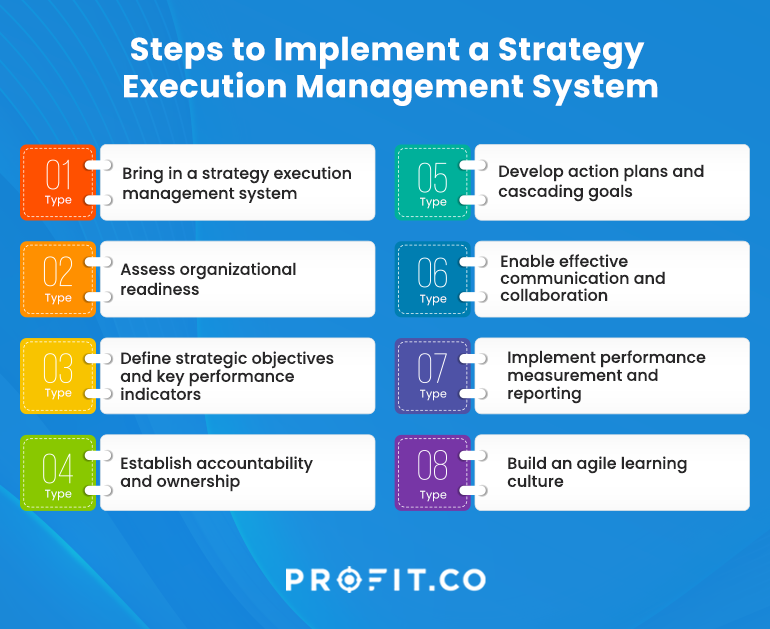Introduction
Strategy is an overarching plan for an organization, and it impacts how work gets done and how goals are set and achieved at every level of the organization. The success of a strategy lies in the strategy execution. If the strategy execution has to garner the support and active participation of every individual in the organization and if it has to consolidate their contribution toward the strategic objectives, then you must ensure the reach of those objectives to all levels of the organization and goal-setting alignment toward the strategic objectives.
To achieve this, you must communicate the strategy, set goals for strategy execution, and create acceptance and ownership of the strategic objectives from the stakeholders. You need to allocate resources and track the progress of your strategy execution. Such an elaborate process of strategy execution requires a systematic approach and a strategy execution management system (SEMS).
What is a Strategy Execution Management System (SEMS)?
A strategy execution management system is a strategy execution framework or software system that facilitates strategy execution. It enables organizations to translate the strategy from the conceptual level, convert it into actionable plans, ensure alignment, execute the plans, and monitor the progress. Implementing a strategy execution management system can be difficult, but it is crucial for achieving your strategic objectives.
Let’s go invent tomorrow rather than worrying about what happened yesterday.
Steps to Implement a Strategy Execution Management System

Following are the steps involved in effectively implementing a strategy execution management system in an organization:
1. Bring in a strategy execution management system
Selecting the right SEMS that suits your needs requires thorough research on the available options, discussing with the management team members the suitability, pros, and cons of those options, and understanding how they will work with your other business system.
Strategy execution benefits from a strategy execution management system in the form of:
- Alignment to the strategic objectives: A strategy execution management system aligns the employees to the strategic objectives. It also aligns team-wise and individual goals with the organization’s strategic objectives. It maps the links between these goals, thus binding everyone to a common purpose.
- Real-time visibility of the progress of various strategic initiatives, thus ensuring transparency and better decision-making.
- Performance measurement by tracking KPIs associated with the strategic objectives.
- Effective resource management, prioritization, and allocation of resources for various strategic initiatives. A SEMS provides insights on resource allocation, availability, and utilization, thus helping you optimize resource allocation to the right strategic priorities.
- Collaboration and communication across different teams and departments. A strategy execution management system enables information sharing and updates on strategic initiatives. It results in enhanced cooperation, coordination, knowledge-sharing, and teamwork within and between the teams.
- Better adaptability and agility. A SEMS helps you track the progress of the strategic initiatives and enables you to adapt your strategy to changing market conditions, internal dynamics, and external factors, such as newly developing trends, risks, and opportunities.
Ready to implement your business unit?
2. Assess organizational readiness
You need to assess the organizational readiness before implementing the strategy execution management system to determine the ability and willingness of the organization to adopt and effectively utilize the system. Without organizational readiness, you cannot achieve widespread acceptance and adoption of the system. As a result, you cannot go ahead with the planning of strategy execution. Assessing organization readiness involves evaluating the following:
- Leadership support to evaluate the top management’s understanding of the importance of strategy execution, commitment and support of the senior executives in SEMS implementation, and the effectiveness with which leaders communicate the vision, benefits, and expected outcomes to create acceptance of SEMS among the stakeholders and employees.
- Organizational culture to understand if the current culture complements and supports the organization’s strategic objectives and fosters accountability, collaboration, continuous improvement, and adaptability; and if the culture has learnings from a history of change that allows employees to embrace new technologies and processes.
- The availability of resources, including financial resources for implementing the strategy execution system, maintaining the software and infrastructure, and providing training; human resources for taking an audit of the skills and expertise and recruiting needs to implement the system; and technical infrastructure, which includes network capabilities, hardware requirements, data security measures, etc.
3. Define strategic objectives and key performance indicators
Clearly defining the strategic objectives and key performance indicators (KPIs) in the SEMS is a crucial step in the strategy execution because:
- Strategic objectives act as a guide to align efforts towards a common purpose, vision, and direction for all activities and initiatives across various levels of the organization.
- They help allocate resources to the right priorities.
- KPIs help gauge progress toward strategic objectives, identify gaps, and take corrective actions at the right time.
- Clear strategic objectives and KPIs establish accountability and create ownership of the initiatives.
- They promote effective communication and a culture of open dialogue and collaboration.
4. Establish accountability and ownership
Individuals and teams must take ownership of their assigned tasks and be responsible for the deliverables. Establishing accountability in strategy execution management system:
- Clarifies the responsibility of individuals and teams for driving specific strategic initiatives.
- Enables performance management.
- Promotes transparent decision-making at all levels.
- Leads to achieving desired outcomes.
- Promotes a sense of ownership and motivation.
- Fosters and sustains a culture of accountability, driving performance.
5. Develop action plans and cascading goals
You can develop action plans by breaking down strategic objectives into SMART goals and outlining the tasks, activities, resources, and timelines for achieving them. As part of the strategy execution process, these goals are cascaded down to various levels of the organization to ensure that the strategic objectives are translated into action across the organization, all aligned from top to bottom, from top-level strategic goals to individual-level goals for employees. Uniform alignment promotes teamwork, coordination, and synergy to produce outcomes forecasted in the strategy execution roadmap.
6. Enable effective communication and collaboration
A strategy execution system helps you enable transparent and timely communication across all levels of the organization. Communication is a key factor in the strategy execution because:
- It ensures access to relevant information for everyone and creates an understanding of the strategic direction at all levels of the organization.
- It encourages open dialogue, discussions, participation, contribution of ideas, knowledge sharing, and feedback.
- It fosters a culture of cross-functional collaboration, teamwork, and innovation, thus enabling employees to work together towards common goals and collectively overcome challenges.
- It leads to better coordination, alignment, and increased engagement levels.
7. Implement performance measurement and reporting
Performance measurement involves constant monitoring of progress against the previously identified KPIs. It entails collecting relevant data and analyzing and comparing performance trends during various periods. Performance measurement in a strategy execution management system uncovers valuable insights into the effectiveness of strategy and strategy implementation, inefficiencies and inadequacies in the strategy execution system, outcomes from the strategic initiatives, and the effectiveness of resource allocation. It enables informed decision-making and enhances organizational performance. The inferences and interpretations are then consolidated and structured as reports and shared with accountable leaders and decision-makers to identify areas of improvement or concern and take timely corrective actions.
8. Build an agile learning culture
The strategy execution process can bring long-term success only when you build an agile learning culture. You must use the communication and information-sharing tools in the strategy execution system regularly to promote sharing of ideas, information, and innovations to carefully build a curious and continuous learning mindset that motivates employees to seek and share knowledge, engage, and embrace new ideas. A learning culture fosters innovation and makes the organization agile enough to adapt to changes and challenges.
FAQs
1. What is strategy execution management?
Strategy execution management systematically manages strategy execution to translate the strategy from the conceptual level, convert it into actionable plans, ensure alignment, execute the plans, and monitor the progress. It helps to bridge the gap between strategic planning and operational execution.
Strategy execution management involves:
- Goal setting
- Action planning
- Resource allocation
- Performance measurement
- Continuous monitoring and review
2. What is the role of the strategy execution manager?
The strategy execution manager should oversee and facilitate the successful implementation of strategic initiatives within an organization. The strategy execution manager’s responsibilities may include:
- Planning and coordinating leaders, departments, and teams.
- Monitoring and evaluating key performance indicators (KPIs) and the effectiveness of implemented strategies.
- Communication and collaboration to ensure information about the strategic objectives, progress, and milestones and promote cross-functional teamwork and knowledge sharing.
- Problem-solving and decision-making to analyze issues, identify root causes, propose solutions to overcome barriers in strategy execution, and make informed decisions.
- Achieving continuous improvement of strategy execution processes.
3. What are the five stages of strategic management?
The five elements of strategic management are:
- Situational analysis
- Strategic planning
- Strategy execution
- Evaluation and control
- Sustainability and institutionalization
4. What is the strategy execution process?
The strategy execution process refers to implementing a strategic plan and taking action to achieve the goals and objectives outlined in the strategy.
Conclusion
Implementing an effective strategy execution management system is vital to organizational success. It’s not enough to create a great strategy; what separates successful companies is how effectively they execute it.
With Profit.co’s intuitive OKR and task management software, your organization can implement a strategy execution management system to guide you toward achieving your strategy.

